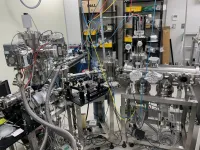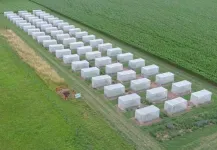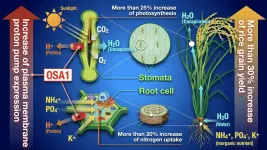(Press-News.org) Massive galaxies with extra-large extended "puffy" disks produced stars for longer than their more compact cousins, new modelling reveals.
In a paper published in the Astrophysical Journal, researchers led by Dr Anshu Gupta and Associate Professor Kim-Vy Tran from Australia's ARC Centre of Excellence in All Sky Astrophysics in 3 Dimensions (ASTRO 3D), show that the sheer size of a galaxy influences when it stops making new stars.
"There's a period in the life of the Universe known as the 'cosmic noon', which occurred about 10 billion years ago," said Dr Gupta.
"That was when star formation in massive galaxies was at its peak. After that, gas in most of these galaxies grew hot - in part because of the black holes in the middle of them - and they stopped forming stars.
"In galaxies that are really, really stretched out, however, we found that things didn't heat up as much and the black holes didn't exert such a great influence, so stars kept getting made over a longer period."
Dr Gupta and Dr Tran, both of whom are based at the University of NSW, Sydney, found that they could predict the end of star formation based on the size of a galaxy's disk - the flat, circular region surrounding its centre, comprising stars, hydrogen gas and dust.
"Where the stars in the disk are widely distributed - you could call it 'puffy' - the gas stays cooler, so continues to coalesce under gravity and form new stars," said Dr Gupta.
"In galaxies with more compact disks, the gas heats up quite quickly and is soon too energetic to mash together, so the formation of stars finishes by just after cosmic noon. Puffy disks keep going much longer, say as far as cosmic afternoon tea."
To make their findings, the researchers, with colleagues from Melbourne, Germany, Mexico and the United States, used cosmological galaxy formation simulations from an international collaboration known as the IllustrisTNG project.
This was integrated with deep observations from an Australian-led project known as the Multi-Object Spectroscopic Emission Line (MOSEL) Survey.
"The IllustrisTNG simulations required millions of hours of supercomputer time," said Dr Tran.
"And the MOSEL survey needs both the WM Keck Observatory in Hawai'i and the Hubble Space Telescope.
"The results mean that for the first time we've been able to establish a relationship between disk size and star-making. So now astronomers will be able to look at any galaxy in the Universe and accurately predict when it will stop making stars - just after lunch, or later in the cosmic afternoon."
The Milky Way, incidentally, is a massive galaxy that is still making stars. That's because it was something of a cosmic late-starter. When cosmic noon arrived it was very small - containing only one-tenth of the star mass it hosts today - and did not attain 'massive' status until much, much later.
As a result, the gas and dust within it has not yet warmed up enough to quench the star-making process.
It is not, however, an extended puffy galaxy, so it will quench, relatively speaking, sooner rather than later.
"Cosmic noon was a long time ago," said Dr Gupta. "I'd say that by now the Universe has reached cosmic evening. It's not night-time yet, but things have definitely slowed down."
INFORMATION:
As well as UNSW, team members hailed from Swinburne University, the Max-Planck-Institut fur Astronomie, the Universidad Nacional Autonoma de Mexico, and the Flatiron Institute and Columbia University, both in New York.
New research suggests that the rate of rainfall within a storm system is linked to the structure and form of the precipitation area as seen on radar. This discovery relies heavily on the "morphology" of radar signatures, including shape (big, small), and size (high, short or plump, thin). Compared to buying diamonds, morphological characteristics are an important reference factor for pricing. Fascinated by "popcorn-shaped" clouds over the Tibetan Plateau, atmospheric scientists have been inspired to study the relationship between cloud shape, precipitation intensity, and the morphology ...
Hokkaido University scientists show that under laboratory conditions, ultraviolet light reacts with nitrophenol to produce smog-generating nitrous acid.
An advanced laser technique has allowed researchers to observe, in real-time, the decomposition of a pollutant into atmospheric nitrous acid, which plays a key role in the formation of ozone and photochemical smog. The technique, described by Hokkaido University researchers in The Journal of Physical Chemistry Letters, could be used in a wide range of applications.
Nitrophenols are a type of fine particulate matter found in the atmosphere that form as a result of fossil fuel combustion and from forest fires. It is hypothesised that light interacts with nitrophenols and breaks them down into nitrous acid; atmospheric nitrous ...
Social interaction may help reverse food and cigarette cravings triggered by being in social isolation, a UNSW study in rats has found.
The study, published in Scientific Reports, used an animal model of drug addiction to show that a return to social interaction gives the same result as living in a rich, stimulating environment in reducing cravings for both sugar and nicotine rewards.
"This was an animal study, but we can probably all relate to the mental health benefits of being able to go for a coffee with our friends and having a chat," lead author Dr Kelly Clemens from UNSW Sydney's School of Psychology ...
The SARS-CoV-2, the new coronavirus behind the current pandemic, infects humans by binding its surface-exposed spike proteins to ACE2 receptors exposed on the cell membranes.
Upon a vaccination or a real infection, it takes several weeks before the immunity develops antibodies that can selectively bind to these spike proteins. Such antibody-labeled viruses are neutralized by the natural killer and T cells operated by the human immunity.
An alternative approach to train the immunity response is offered by researchers at the University of Illinois Chicago and California State University at Sacramento who have developed a novel strategy that redirects antibodies for other diseases existing in humans to the spike proteins ...
A higher diversity of flowering plants increases the breeding success of wild bees and may help compensate for the negative effects of insecticides. This is what researchers from the Universities of Göttingen and Hohenheim, as well as the Julius Kühn Institute, have found in a large-scale experimental study. The results have been published in the scientific journal Ecology Letters.
In their experiment, the researchers investigated how successfully the wild bee Osmia bicornis (red mason bee) reproduced. Red mason bees are important for both ecological and economic ...
Researchers in Costa Rica have found that some bacteria on the skin of amphibians prevent growth of the fungus responsible for what has been dubbed 'the amphibian apocalypse'.
Published in the journal Microbiology, the research identified a number of bacteria which could growth of the fungus Batrachochytrium dendrobatidis (Bd). One particularly dangerous strain of the fungus, called BdGPL-2, is responsible for mass amphibian die-offs around the world.
The fungus infects the skin of amphibians, breaking down the cells. As amphibians breathe and regulate water through their skin, infection is often deadly. It is believed that almost 700 species of amphibian are vulnerable to the ...
A group of scientists led by Drs Toshinori Kinoshita and Maoxing Zhang (Institute of Transformative Bio-Molecules,Nagoya University, Japan) and Dr Yiyong Zhu (Jiangsu Collaborative Innovation Center for Solid Organic Waste Utilization, Nanjing Agricultural University, China) have developed a method which, by increasing the number of a plasma membrane proton pump gene in rice, simultaneously increases nutrient uptake through the roots and stomatal opening, thus increasing the yield of paddy field grown rice by over 30%.
In their previous research, the group had found that the plasma membrane proton pump played an important role in influencing stomatal opening. When they created a variant of rice with an overexpression of a particular plasma membrane proton pump gene, they found ...
Modern-day robots are often required to interact with humans intelligently and efficiently, which can be enabled by providing them the ability to perceive touch. However, previous attempts at mimicking human skin have involved bulky and complex electronics, wiring, and a risk of damage. In a recent study, researchers from Japan sidestep these difficulties by constructing a 3D vision-guided artificial skin that enables tactile sensing with high performance, opening doors to innumerable applications in medicine, healthcare, and industry.
Robots have come a long way since their original inception for high-speed automation. Today, robots can be found in a wide variety of roles in medicine, rehabilitation, agriculture, and marine navigation. Since a ...
Modern immunotherapeutic anti-cancer drugs support a natural mechanism of the immune system to inhibit the growth of cancer cells. They dock onto a specific receptor of the killer cell and prevent it from being switched off by the cancer cells. This is a complex molecular process, which is known but has not yet been fully understood. In a molecular dynamics study conducted by the group led by medical information scientist Wolfgang Schreiner and gynaecologists Heinz Kölbl and Georg Pfeiler from MedUni Vienna, working with biosimulation expert Chris Oostenbrink ...
What are the reasons for such a contrast in outcomes? A scientist team led by the Leibniz Institute for Zoo and Wildlife Research (Leibniz-IZW) has now analysed the humoral innate immune defence of European greater mouse-eared bats to the fungus. In contrast to North American bats, European bats have sufficient baseline levels of key immune parameters and thus tolerate a certain level of infection throughout hibernation. The results are published in the journal "Developmental and Comparative Immunology".
During infections caused by Pseudogymnoascus destructans (Pd), North American bats arouse frequently from ...







